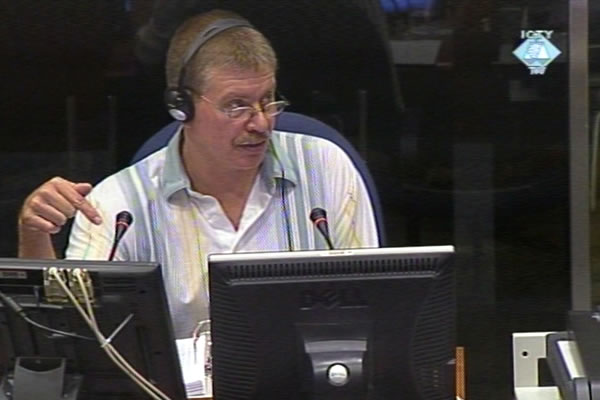Home
CROATIAN SOLDIERS WERE ONLY INHABITANTS IN KISTANJE
In his description of the situation in Krajina in the aftermath of Operation Storm, Canadian officer Jeffrey Hill said that Serbian houses were looted by soldiers, police and civilians. The worst situation, he said, was in the village of Kistanje near Benkovac on 8 August 1995 where Croatian soldiers ’moved in’
 Jeffrey Hill, witness at the Gotovina, Cermak and Markac trial
Jeffrey Hill, witness at the Gotovina, Cermak and Markac trial Jeffrey Hill, former commander of the UN military police in the Sector South, visited Krajina after Operation Storm, after the Croatian Army and police had already moved into the area. He wrote down his observations in a diary that was today tendered into evidence at the trial of Ante Gotovina, Ivan Cermak and Mladen Markac. As his examination-in chief continued, the Canadian officer confirmed that what he wrote in there was true. In addition to this, he recounted what he saw when he visited the villages and towns in Krajina from 6 to 12 August 1995.
Before going to visit Sector South – Krajina – he drove through Knin with a member of the Security and Information Service. The town was full of armed Croatian soldiers drinking and celebrating, Hill recounted. They were also taking electronic devices and other valuables from Serbian houses. His escort talked to a Croatian woman, Hill said, and then wrote down something on a piece of paper and stuck it to the doors of her house. The property was thus certified as Croatian and the soldiers would not touch it. According to Hill, he saw identical papers on other houses that were indeed left untouched. Apart from the looting, the witness recounted, he saw a lot of houses that had been burned down in Knin, but the damage caused by shells was not as extensive as he had expected.
On his way to Drnis on 8 August 1995 he saw civilians looting Serbian houses, loading the loot on to their cars; the license plates indicated they were from towns in Southern Dalmatia. Apart from them, he noted a strong Croatian civilian police presence in the area. They controlled traffic and also took part in the looting. The worst situation was in the village of Kistanje in Benkovac municipality. As he put it, the Croatian soldiers were the only ’inhabitants’ there. Serbs had fled and their houses were looted and burned down. The monument to the victims of fascism erected after World War II in the village center was smashed by hammers. In Canada, the witness added, this is called ’vandalism’.
Despite the ‘strong stench of dead bodies’ in Kistanje, Gracac and other villages he visited, Hill admitted that he did not seen any dead civilians there. However, on a hill near Knin he saw two bodies in civilian clothes with gunshot wounds to their heads. The photos he took on that occasion were tendered into evidence today. Along the route Serbian civilians and soldiers took as they retreated towards BH he saw broken down cars with personal possession scattered all over. He also saw six bodies, four in uniform and two in civilian clothes. Next to the road he noticed several broken down SRK tanks.
The cross-examination of the Canadian officer that began today was completed this afternoon in the additional hearing scheduled so that the witness could leave for home in the evening.
Linked Reports
- Case : Gotovina et al. - "Operation Storm"
- 2008-05-23 DEFENSE: CIVILIANS RESPONSIBLE FOR CRIMES
- 2008-05-22 WERE CRIMES INVESTIGATED?
- 2008-05-19 GOJANOVIC DEFENDS ‘HONOR AND DIGNITY’
- 2008-05-29 ARMY AND POLICE DIDN’T WANT WITNESSES
- 2008-06-02 CROATS WERE THE SAME AS SERBS
- 2008-06-03 GENERAL FORAND’S PROTESTS WERE IN VAIN
